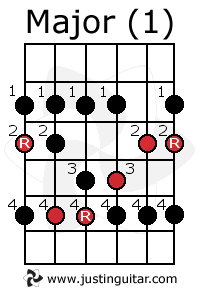JustinGuitar.com uses cookies to enhance your browsing experience. By continuing to use this site, you consent to the use of cookies. For more detailed information, please review the full Terms & Conditions.
🚨 Save Your Songs, Save Your Rhythm—Save 50%! 🎸 Get the Strumming SOS Course at half price, but only for a limited time!
Now I hope at this stage now you have the Major Scale in your memory, right? So now we're going to change how you think about scales for good - it's a little idea, but with BIG consequences - and will help you make music out of scales and break out of old bad habits.
The reason we learn scale fingerings is to be able to play a scale easily and efficiently. But when we play solos (either learned or improvised) the notes are very rarely in the same order as as just playing the scale up and down (that would be very boring to listen to!). Many people get restricted by scale fingerings, so I want you to try a little exercise for me...
Start by playing the note on the 5th fret on the fourth string, and use your 1st finger. Now use your 3rd finger. Did it sound any different? Really listen closely. Real close. Hear any difference? Me neither :)
So it's really important to realise that scales show you notes that sound good together in a key (more on keys later) but the fingering is only important when you play scales! When you are making up a solo - use whatever finger you like! Nobody sticks to the "right fingers" all the time when they play - they explore and experiment - and you should too! Get into the habit now!

You should already have this in your memory but many people find it hard when they start trying to do the one finger thing, so I thought I would leave it here for those that are struggling...
But DON'T use the diagram if you don't need to!
So the trick here is to learn to play solos with ONE FINGER!
Maybe it sounds crazy to you right now but it sure won't when you have been playing this way for a while. It really works. The point is to get you to break out of the box - most people will practice a scale a lot and learn it properly which is great and important - but the good thing about lots of practice (muscle memory) also makes a problem because the fingers will naturally want to play the scale. But we don't want to play scales - we want to play music!
Using only one finger you should find that your ears tune in more. Try it and see. Have a play with this free backing tracking in G Major.
But lets get a couple of things straight!
By far the best (only?) way to practice this is to use it! Either with a jam buddy, recording yourself and playing over it or a Backing Track (or This Free G Major Backing Track).
Put on the backing track and solo for the full 5 minutes with just your first finger - do not let any other fingers sneak in there - just use the one. Explore the idea. Let your EARS be the guide to what notes to play!
You should find too that you end up playing notes in an unusual order (crossing from one string to another is as easy as going up and down a string!) and sometimes this will sound cool, and sometimes it won't. Repeat the ones that sound good so you might remember them, forget the ones that don't sound cool!
I'm hoping you will find this very refreshing and help you come up with some interesting ideas.
Once you have done it a few times you might like to try working on slides too - they are lots of fun.

Learn how to play Half the World Away by Oasis—a great song for advancing beginners. :) We'll explore unique chord grips like C/G and Fmaj7/C that add a special flavor to the melody. From the intro to the chorus, this song takes you on a musical journey with chords like C, F, A minor, D7, and more.